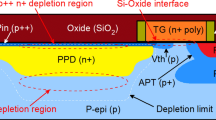Abstract
A double photodiode (PD) constructed by p+/N-well junction and N-well/p-sub junction was designed and fabricated in a UMC 0.18-μm CMOS process. Based on the device structure and mechanism of double PD, a novel small-signal equivalent circuit model considering the carrier transit effect and the parasitic RC time constant was presented. By this model with complete electronic components, the double PD can be incorporated in a commercial circuit simulator. The component values were extracted by fitting the measured S-parameters using simulated annealing algorithm, and a good agreement between the measurement and the simulation results was achieved.







Similar content being viewed by others
References
Zhou ZP, Tu ZJ, Li TT et al (2015) Silicon photonics for advanced optical interconnections. J Lightwave Technol 33:928–933
Jonathan KD, Andrew PK (2012) The evolution of silicon photonics as an enabling technology for optical interconnection. Laser Photonics Rev 6:504–525
Xie S, Tao XZ, Mao LH et al (2016) High-Gm differential regulated cascode transimpedance amplifier. Trans Tianjin Univ 22:345–351
Behrooz N, Sagar R, Mona MH (2012) High speed photodiodes in standard nanometer scale CMOS technology: a comparative study. Opt Express 20:11256–11270
Tang L, Latif S, Miller DAB (2009) Plasmonic device in silicon CMOS. Electron Lett 45:706–708
Huang SH, Chen WZ, Chang YW et al (2011) A 10-Gb/s OEIC with meshed spatially-modulated photo detector in 0.18-µm CMOS technology. IEEE J Solid-State Circuits 46:1158–1169
Pan Q, Hou ZX, Wang YP et al (2014) A 48-mW 18-Gb/s fully integrated CMOS optical receiver with photodetector and adaptive equalizer. IEEE symposium on VLSI circuits—digest of technical paper: 6858402
Chen WY, Liu SY (1996) PIN avalanche photodiodes model for circuit simulation. IEEE J Quantum Electron 32:2105–2111
Wu JY, Wang G (2010) A novel equivalent circuit model for separate absorption grading charge multiplication avalanche photodiode (APD)-based optical receiver. J Lightwave Technol 28:784–790
Lee MJ, Kang HS, Choi WY (2008) Equivalent circuit model for Si avalanche photodetectors fabricated in standard CMOS process. IEEE Electron Device Lett 29:1115–1117
Mao LH, Chen HD, Wu RH et al (2002) Simulation and design of a CMOS-process-compatible high-speed Si-photodetector. Chin J Semicond 23:193–197 (in Chinese)
Dai DX, Piels M, Bowers JE (2014) Monolithic germanium/silicon photodetectors with decoupled structures: resonant APDs and UTC photodiodes. IEEE J Sel Top Quantum Electron 20:3802214
Lu CN, Sou G, Devigny F et al (2001) Design and testing of a CMOS BDJ detector for integrated micro-analysis systems. Microelectron J 32:227–234
Paul DH, Dylan FW (2003) Calibrated measurement of optoelectronic frequency response. IEEE Trans Microwave Theory 51:1422–1429
Mohammad S, Ali J (2015) An evolutionary-based methodology for symbolic simplification of analog circuits using genetic algorithm and simulated annealing. Expert Syst Appl 42:1189–1201
Kazutoshi K, Susumu H, Kenji K et al (1993) Design of ultrawide-band, high-sensitivity p-i-n photodetectors. IEICE Trans Electron E76-C:214–221
Acknowledgements
This study was supported by the National Natural Science Foundation of China (No. 61474081) and Guangxi Key Laboratory of Precision Navigation Technology and Application, Guilin University of Electronic Technology (No. DH201513).
Author information
Authors and Affiliations
Corresponding author
Rights and permissions
About this article
Cite this article
Xie, S., Luo, X., Mao, L. et al. Design, Fabrication, and Modeling of CMOS-Compatible Double Photodiode. Trans. Tianjin Univ. 23, 163–167 (2017). https://doi.org/10.1007/s12209-017-0038-1
Received:
Revised:
Accepted:
Published:
Issue Date:
DOI: https://doi.org/10.1007/s12209-017-0038-1




